The 2013 MacBook Air Review (13-inch)
by Anand Lal Shimpi on June 24, 2013 12:01 AM ESTThe GPU: Intel HD 5000 (Haswell GT3)
Hire enough ex-ATIers and you’ll end up really caring about GPU performance apparently. It’s good to see that Apple still views increasing GPU performance as non-negotiable, even at the MacBook Air level. Discrete GPUs are out of the question in the MacBook Air, so all models ship with Intel’s on-die processor graphics. More importantly, all CPU choices integrate the largest GPU offering: Intel’s HD 5000 (aka GT3).
Clock speeds alone prevent the 40 EU GPU implementation from being called an Iris 5100. Given the 15W TDP limit, Intel wouldn’t be able to do the Iris name justice even if it tried.
It’s hilarious that Intel refused to give out die photos for anything other than quad-core Haswell GT2, citing competitive concerns, yet at Apple’s WWDC launch of the new MacBook Airs we got to see the first die shot of a dual-core Haswell GT3. Update: I stand corrected. Intel posted its own shot here.
From the die photo it’s very obvious that like the quad-core Haswells with Iris Pro, the dual-core GT3 parts are over half GPU. Here's the only Haswell die shot Intel PR officially released by comparison, a quad-core GT2 part that's mostly made up of CPU cores:
Similar to the CPU discussion, on the GPU front Haswell has to operate under more serious thermal limits than with Ivy Bridge. Previously the GPU could take the lion’s share of a 17W TDP with 16 EUs, now it has 15W to share with the PCH as well as the CPU and 2.5x the number of EUs to boot. As both chips are built on the same 22nm (P1270) process, power either has to go up or clocks have to come down. Intel rationally chose the latter. What you get from all of this is a much larger GPU, that can deliver similar performance at much lower frequencies. Lower frequencies require lower voltage, which in turn has a dramatic impact on power consumption.
Take the power savings you get from all of this machine width, frequency and voltage tuning and you can actually end up with a GPU that uses less power than before, while still delivering incrementally higher performance. It’s a pretty neat idea. Lower cost GPUs tend to be smaller, but here Intel is trading off die area for power - building a larger GPU so it can be lower power, instead of just being higher performance.
| A Historical Look at MacBook Air GPU Performance | |||||||||
| 2011 | 2012 | 2013 | |||||||
| GPU | Intel HD 3000 | Intel HD 4000 | Intel HD 5000 | ||||||
| Manufacturing Process | 32nm | 22nm | 22nm | ||||||
| Frequency | 350/1150MHz | 350/1050MHz | 200/1000MHz | ||||||
| Cores | 12 | 16 | 40 | ||||||
| Peak GFLOPS | 165.6 GFLOPS | 268.8 GFLOPS | 640 GFLOPS | ||||||
| TDP | 17W | 17W | 15W | ||||||
This is an even bigger deal because few of the other OEMs seem interested in paying for the larger die. Acer’s S7 uses Intel’s HD 4400 (Haswell GT2, 20 EUs), as do most of the other Haswell Ultrabooks that have been announced thus far. Armed with a 2011, 2012 and 2013 MacBook Air as well as Acer’s 2nd generation S7, we now have the ability to compare everything from Intel’s HD 3000 (Sandy Bridge) all the way up to HD 5000. It’s important to keep in mind that with the exception of HD 3000, everything here is built on the same 22nm process, and with HD 4400/5000 TDPs actually went down. In other words, post Ivy Bridge, any GPU performance gains were very hard to come by.
I’m splitting up the GPU performance data into three sections. The first is a look at some games/settings that are actually playable on processor graphics. The second is comparison data for laptop Bench. The deltas here are academic at best since nothing slower than Iris Pro can really deliver playable frame rates in our high-end notebook GPU tests. The final section focuses on synthetic performance, which should help characterize the peak theoretical gains you can expect from HD 5000.
All of the gaming tests were run under Boot Camp/Windows 8. I think it’s time to retire the HL2/Portal testing under OS X.
Playable Gaming Performance
There's a surprising number of games that are actually playable on Intel's HD 5000 in the MacBook Air. You have to be ok with the fan spinning quite loudly, but it's possible to get some ultra portable gaming in if you're up for it.
For all of these tests I stuck with 1366 x 768 so I could run comparable data on the only HD 3000 equipped MBA I had, an 11-inch model. I also threw in data from Inte's HD 4400 using the new Haswell equipped Acer S7. I'll start with GRID 2, a brand new racer, running at relatively low quality settings.
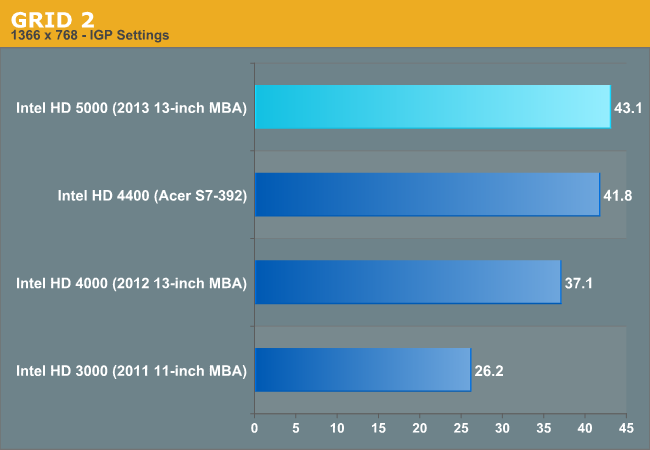
GRID 2 is absolutely playable on the new MacBook Air. At 43.1 fps it's 16% faster than last year's HD 4000 model. A 16% gain without increasing TDP on the same manufacturing process is pretty impressive. The gains over the 2011 MBA are substantial. GRID 2 goes from almost playable to fast enough where you can actually turn up some of the quality settings if you wanted to.
Next up is Borderlands 2. Again, a fairly modern title, but one that's really optimized for current generation consoles - making high-end processor graphics more than up for the task. While a higher TDP implementation of Haswell's integrated graphics wouldn't have an issue here, things are a little more difficult with a 15W TDP.
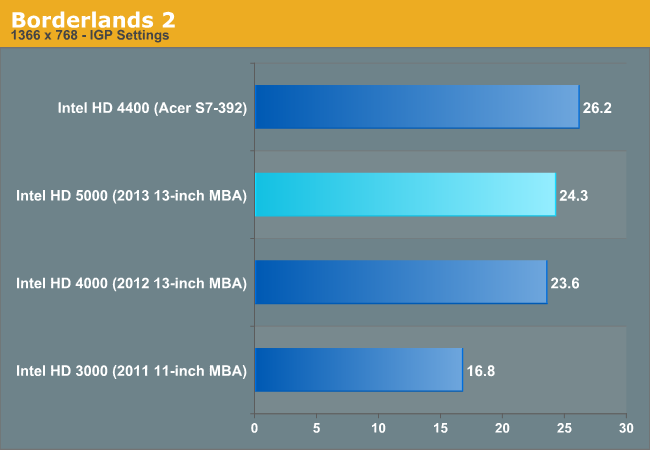
We see a marginal improvement over the HD 4000, we're clearly thermally bound at this point. What's interesting is the HD 4400 on the S7 is actually quicker here. The difference could be cooling or how Apple decides to scale back on GPU frequency when faced with thermal limits. A quick look at Haswell's power reporting confirms that while running my Borderlands 2 test the GPU was already exceeding the PL1 (Power Limit 1) of 15W:

Remember, with Sandy Bridge Intel introduced Turbo Boost 2.0 that effectively allowed for two separate power limits - one equal to the processor's TDP (PL1) and one higher than the processor's TDP (PL2) that could be hit as long as the die temperature doesn't get too high.
Despite the sub 30fps frame rate in this benchmark, Borderlands 2 was definitely playable on the HD 5000. It wasn't always smooth but if you need your single player fix, it'll suffice.
I've had a few requests to bring back our Minecraft benchmark. We ditched it from our higher end GPU reviews since it's no longer stressful enough, but for 15W TDP iGPUs it's perfect.
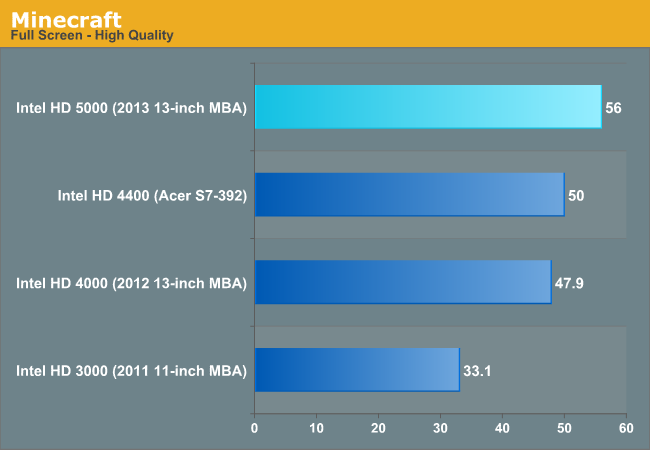
Once again we see almost a 17% increase over Intel's HD 4000. The HD 4400 comparison is also very impressive with a 12% increase in performance vs. what most MBA competitors will be using.
When I was a kid all I wanted was a console that could play arcade quality ports of Street Fighter II and Mortal Kombat II. These days, even the latest Street Fighter title has no issue playing on free graphics:
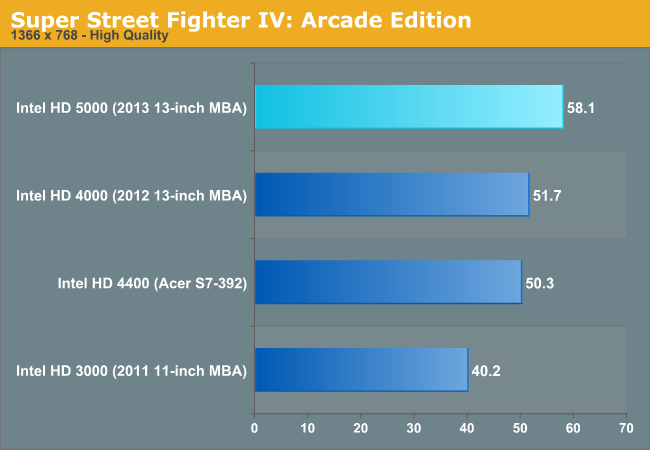
16% seems to be the magic number as that's exactly how much faster HD 5000 is compared to HD 4000. Given the lower TDP this year, that's a pretty reasonable gain. Looking at the sheer number of transistors that had to be used to get there however gives you good insight into just how hard it is to improve performance without a corresponding process node shrink.



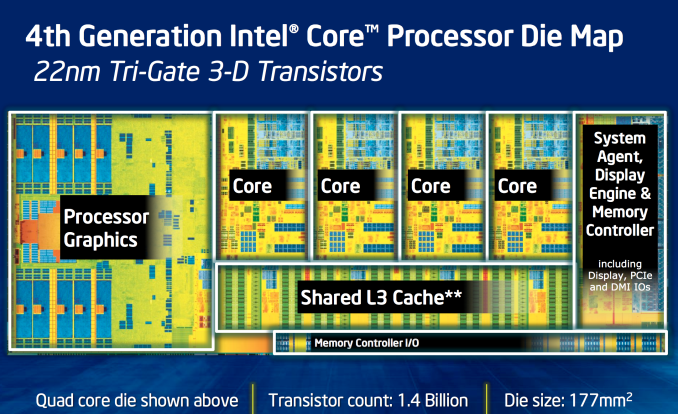
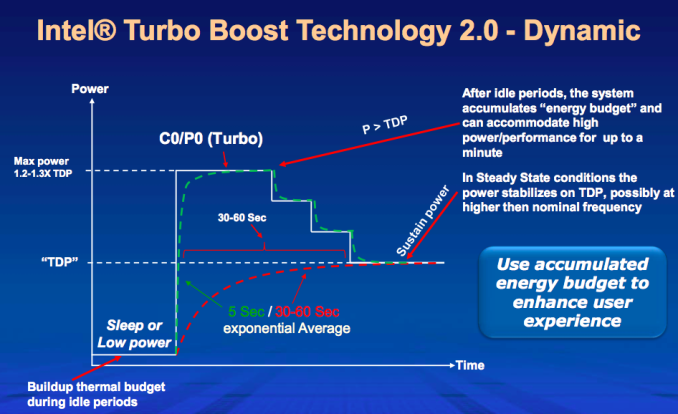








233 Comments
View All Comments
JDG1980 - Monday, June 24, 2013 - link
I think we should have seen noise and thermal measurements, especially since this is Haswell. Will you be able to sit it on your lap without burning yourself? The desktop Haswell chips get nearly hot enough to boil water. I don't believe Intel's official TDP ratings for Haswell; the 4770K allegedly dissipated only 84 watts, but generated more heat than a 130W Sandy Bridge-E.Assuming you plan to use OSX (I can't stand it myself), the low resolution is a real killer. Windows is the only OS that has good font rendering at low DPI (via ClearType). On OSX everything is a blurry mess, and on Linux it's even worse. (Rendering at low DPI is much harder since they have to use a bunch of hacks like hinting and sub-pixel antialiasing to get the font to fit the pixel grid and look reasonably clear.)
It's disappointing to see Apple using Elpida RAM; it's far worse than Hynix or Samsung. And end users shouldn't expect to get the Samsung panel reviewed here; they will almost certainly end up with an inferior LG panel unless they return the system and complain. That's what happened with the rMBP last generation. The sales tactics came close to bait and switch, IMO: send out a good product to reviewers, then after a few months of sales, switch to inferior parts for future production without any indication on the packaging or labeling.
FwFred - Monday, June 24, 2013 - link
Temperature != heat. Also, there is no IHS on a mobile part, so the CPU die may directly be mounted against the cooling solution.mavere - Monday, June 24, 2013 - link
No IHS means no TIM issues means TDP has an extremely, extremely strong correlation to heat and noise, especially as teardowns show similar internal construction. Like the review said, TDP is respectably lowered in Haswell.>>> "It's disappointing to see Apple using Elpida RAM; it's far worse than Hynix or Samsung."
By what metric? Are you claiming that the RAM won't reach their rated speeds? Or are you claiming there's a pending RAM death situation here?
I would love citations in any case.
star-affinity - Monday, June 24, 2013 - link
Don't agree on OS X. It's great overall, once you get used to it. A good start is to not expect everything to behave like in Windows. Also don't agree on the font rendering. If you think it looks better in Windows I'm guessing you're not really into graphic design?tipoo - Thursday, November 6, 2014 - link
I think it does look better, I'm not a graphic designer. However I know OSX may have fonts that are more true to what they were designed as, Cleartype dramatically improves edges on low res displays and makes them bearable. Each pixel effectively becomes three pixels of resolution, so edges are much much smoother. OSX may have "truer" fonts, but chunky looking.A5 - Monday, June 24, 2013 - link
That 130W SB-E die is significantly larger than the 84W Haswell die. Once you add in the fact that more of that TDP is actually being used due to the on-package VRMs, it is pretty obvious why a Haswell would be hotter at the same loads.Paapaa125 - Monday, June 24, 2013 - link
I just used MBA 2011 11" model and the resolution is just fine. At normal viewing distances (30-40cm) the text look clear - no pixels. 135ppi at 40cm means one pixel covers 1,5 arcminutes. That is actually very small unit and quite close to eye resolving power. Definitely you can see the pixels when viewing closer but for normal distances the resolution is 100% sufficient for getting the job done.helloworldv2 - Monday, June 24, 2013 - link
I've been running some terminal stuff for multiple hours with the new i7 model (8GB RAM) utilizing 100% of both cores (4 cores with hyperthreading) and at no point the laptop got uncomfortable to hold on lap (bare skin)..akdj - Wednesday, June 26, 2013 - link
A) Thermal measurements. BS. You don't think the reviewer would've brought to our attention the fact he burned his lap while watching a movie? It's drawing less power at lower clock speeds...there isn't an expectation that the 'heat' on the outside would be anymore significant than the 11/12 core i models. Noise was commented on. In comparison to last year's model, it was quieter while rendering I believe. As well...he mentioned several times throughout the article his anticipation testing the i7 model when he's done flying around the world....yet still submitting a tremendous 'initial' over view or the new Airs. Believe Intel or not....these are 15watt chips. Not 85. Not 130. They're not gonna hurt ya bud.B) OSx. Now your comments are becoming a bit more clear. I use Windows 7/8 and OSx daily. Your comments on text are clearly based on 'what you've heard' and nothing to do with reality. In fact, my friend...'Tis Windows that has awful 'scaling' implementation when it comes to hiDPI displays....including any non native Windows software on the Surface pro. Very troublesome and hopefully will be addressed in 8.1. You're comments on a 'blurry mess' are nothing but BS. @ over 135 dpi on the standard 11" Airs, the resolution in relation to the size of the monitor are just fine! 1080p on that sized display without the same pixel doubling tricks used on the rMBPs would be truly unreadable for most folks over 12 years old! Seriously! I'm an Air and rMBP owner....as well as a PC high resolution display owner. While windows does have some benefits to 'ClearType'....OSx has NO issues with text display. While I'd like to so them step up to IPS, their TN panels, out of the box...have lead the industry for years. Objectively and subjectively. There is NO argument. Windows...on the other hand....they've got a way to go. ClearType isn't the answer. They'll need to implement the same trickery as OSx for text display on HiDPI monitors. No one can see, much less make use of a 2880x1800 display in native Rez. That's the cool thing OSx has managed to pull off....while pixel doubling for text...pics, video, and other creative work can be displayed @ it's native resolution while 'inside' an app using the pixel doubling for its interface. EG; photoshop, FCP....where you CAN have the entire 1080p, every pixel represented inside your canvas while the UI remains usable and crystal clear
Elpida RAM. You are awar that Apple has achieved near 100% efficiency now with their 'soldiered in' RAM. Something NO other user replaceable RAM system can compete with. There are no issues with Elpida...other than the fact you've not heard about them.
LG vs Samsung...very, very arguable. I ended up with an LG in one of our two rMBPs. In four months, image retention set in and Apple immediately replaced it. No questions asked. That said, LG is one of the Biggest and Best panel manufacturers in the world. LG panels in comparison to Samsung have shown better contrast, white and black point....and higher brightness. My Samsung is warmer, but calibrated I've got it pretty close to 6500°. LG is absolutely NOT 'inferior'. They changed out their original panel in the rMBP with an updated version. This is new technology, after all....there are going to be hiccups.
Your 'bait n switch' conspiracy theory is just that. As a small business owner....and as fa from a 'tech reviewer' as one could be....each of my rigs has performed in parity with reviewed models from sites like Anand. No different.
You're full of a WHOLE LOTTA hot air....and obviously have some sort of vendetta against Apple and OSx. Not sure why, maybe your mom said 'Absolutely Not!' When you asked if she would buy you one. Who knows...but quit with the drivel
gxtoast - Monday, June 24, 2013 - link
Fantastic article! However, I just wanted to hit something on the head that seems to be a common misperception:"...In living situations where you can’t just run a bunch of Cat6 everywhere, but still want high speed networking, 802.11ac could be a real alternative."
It seems that most people think that installing Cat6 will give them better 1Gbps Ethernet performance. It won't. Cat6 is irrelevant for 1Gbps. Cat6 is a 10Gbps standard. Cat5e is the 1Gbps standard.
Cheers :)